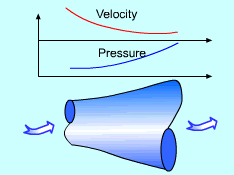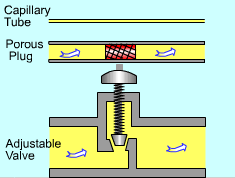| Ch 4. Energy Analysis | Multimedia Engineering Thermodynamics | ||||||
|
Steady-flow Process |
Steady-flow Devices (1) |
Steady-flow Devices (2) |
Steady-flow Devices (3) |
Unsteady-flow Process |
|||
| Steady-flow Devices (1) | Case Intro | Theory | Case Solution |
| Chapter |
| 1. Basics |
| 2. Pure Substances |
| 3. First Law |
| 4. Energy Analysis |
| 5. Second Law |
| 6. Entropy |
| 7. Exergy Analysis |
| 8. Gas Power Cyc |
| 9. Brayton Cycle |
| 10. Rankine Cycle |
| Appendix |
| Basic Math |
| Units |
| Thermo Tables |
| Search |
| eBooks |
| Dynamics |
| Fluids |
| Math |
| Mechanics |
| Statics |
| Thermodynamics |
| Author(s): |
| Meirong Huang |
| Kurt Gramoll |
| ©Kurt Gramoll |
| |
||
| Many engineering devices operate essentially under the same
conditions for long periods of time. These devices can be treated
as steady-flow devices. Recall, the energy balance for a control volume is: |
||
| Nozzles and Diffusers |
||
|
|
Nozzles and diffusers are commonly utilized in jet engines, rockets, and spacecrafts. Any fluid-mechanical device designed to accelerate a flow is called a nozzle and any fluid-mechanical device designed to decelerate a flow is called a diffuser. For subsonic flow (velocity under the speed of sound), a converging duct is a nozzle and a diverging duct is a diffuser. Nozzle and diffuser are single-stream (one-inlet-one-exit) systems. If the inlet is denoted by subscript 1 and exit is denoted by subscript 2, the mass balance and energy balance for single-stream steady-flow systems become There are several common assumptions that are made in the energy analysis of nozzles and diffusers:
Summarizing the above analysis, the energy balance for nozzles and diffusers is: (h2 - h1) + ( v22 - v12)/2 = 0 |
|
| Throttling Devices |
||
|
|
A significant reduction in pressure can be achieved by introducing a restriction into a line through which a gas or liquid flows. This is commonly done by means of an adjustable valve, a porous plug, or a capillary tube. They are called throttling devices. There are several common assumptions that are made in the energy analysis of throttling devices:
Hence, the energy balance for throttling devices is: h2 = h1 When the flow through a valve or other restrictions is idealized in this way, the process is called a throttling process. |
|




